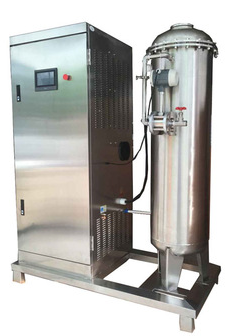Disinfection – UV System, Ozonation, Chlorination
UV SYSTEM
Ultraviolet germicidal irradiation (UVGI) is a disinfection method in water treatment that uses short-wavelength UV disinfects water containing bacteria and viruses and can be effective against protozoans like, Giardia lamblia cysts or Cryptosporidium oocysts. Ultraviolet (UV-C) light to kill or inactivate microorganisms by destroying nucleic acids and disrupting their DNA, leaving them unable to perform vital cellular functions.
UV disinfection can also be used as a virus barrier against Adenovirus, and in a multi-barrier strategy to provide confidence in the water supply.

OZONATION
Ozonation is a water treatment process that destroys microorganisms and degrades organic pollutants through the infusion of ozone, a gas produced by subjecting oxygen molecules to high electrical voltage. This process is called Corona Discharge method. Ozone is an unstable gas comprising of three oxygen atoms, the gas will readily degrade back to oxygen, and during this transition a free oxygen atom, or free radical form. The free oxygen radical is highly reactive and short lived.
The effectiveness of ozone results from its powerful oxidising effect on chemicals and microorganisms caused by the generation of reactive oxygen species during ozone transformation to oxygen. Ozone directly attacks the surface of microorganisms and destroys their cell walls. The cells thus loose their cytoplasm and can no longer reactivate themselves. Ozone can induce an oxidative degradation of many organics and leaves more biodegradable compounds. Besides, ozone can oxidise metallic ions such as Fe(II), Mn(II) or As(III) producing insoluble solid oxides that can be easily separated from water by filtration or sedimentation.
Whilst ozone is more effective than chlorine in inactivating viral agents, there are significant disadvantages to its use. Ozone does not provide residual protection against re contamination during distribution and as ozone affects biological stability, it may encourage re-growth of bacteria. However, given the concerns about the use of chlorine in many countries because of the formation of toxic disinfection by-products (DBP), the use of ozone is increasingly investigated and the lack of residual may be dealt with by employing regular booster ozonation during distribution.

CHLORINATION
Although several methods eliminate disease-causing microorganisms in water, chlorination is the most commonly used. Chlorination is a chemical disinfection method that uses various types of Chlorine or Chlorine containing substances. Chlorine is available as Compressed Elemental gas, Sodium Hypochlorite solution -NaOCl or Calcium Hypochlorite -Ca(OCl)2.
Chlorine inactivates a micro organism by damaging its cell membrane. Once the cell membranes is weakened, the chlorine can enter the cell and disrupt cell respiration and DNA activity – the two processes that are necessary for cell survival.
Any type of chlorine that is added to water during the treatment process will result in the formation of hypochlorous acid (HOCl) and hypochlorite ions (OCl-), which are the main disinfecting compounds in chlorinated water.
Chlorine + H2O ->HOCl +OCl
Of the two, hypochlorous acid is the most effective. The amount of each compound present in the water is dependent on the pH level of the water prior to addition of chlorine. At lower pH levels, the hypochlorous acid will dominate.
The amount of chlorine that is required to disinfect water is dependent on the impurities in the water. The chlorine will react with impurities and then leaves a residual chlorine. This is called Chlorine Demand. Once the chlorine demand is met.
